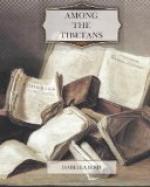Some of the ashes are taken to the gonpos, where the lamas mix them with clay, put them into oval or circular moulds, and stamp them with the image of Buddha. These are preserved in chod-tens, and in the house of the nearest relative of the deceased; but in the case of ‘holy’ men, they are retained in the gonpos, where they can be purchased by the devout. After a cremation much chang is consumed by the friends, who make presents to the bereaved family. The value of each is carefully entered in a book, so that a precise return may be made when a similar occasion occurs. Until the fourth day after death it is believed to be impossible to quiet the soul. On that day a piece of paper is inscribed with prayers and requests to the soul to be quiet, and this is burned by the lamas with suitable ceremonies; and rites of a more or less elaborate kind are afterwards performed for the repose of the soul, accompanied with prayers that it may get ‘a good path’ for its re-birth, and food is placed in conspicuous places about the house, that it may understand that its relatives are willing to support it. The mourners for some time wear wretched clothes, and neither dress their hair nor wash their faces. Every year the lamas sell by auction the clothing and ornaments, which are their perquisites at funerals. {2}
The Moravian missionaries have opened a school in Leh, and the wazir, finding that the Leh people are the worst educated in the country, ordered that one child at least in each family should be sent to it. This awakened grave suspicions, and the people hunted for reasons for it. ’The boys are to be trained as porters, and made to carry burdens over the mountains,’ said some. ‘Nay,’ said others, ’they are to be sent to England and made Christians of.’ [All foreigners, no matter what their nationality is, are supposed to be English.] Others again said, ‘They are to be kidnapped,’ and so the decree was ignored, till Mr. Redslob and Dr. Marx went among the parents and explained matters, and a large attendance was the result; for the Tibetans of the trade route have come to look upon the acquisition of ‘foreign learning’ as the stepping-stone to Government appointments at ten rupees per month. Attendance on religious instruction was left optional, but after a time sixty pupils were regularly present at the daily reading and explanation of the Gospels. Tibetan fathers teach their sons to write, to read the sacred classics, and to calculate with a frame of balls on wires. If farther instruction is thought desirable, the boys are sent to the lamas, and even to the schools at Lhassa. The Tibetans willingly receive and read translations of our Christian books, and some go so far as to think that their teachings are ‘stronger’ than those of their own, indicating their opinions by tearing pages out of the Gospels and rolling them up into pills, which are swallowed in the belief that they are an effective charm. Sorcery is largely used in the treatment of the sick. The books which instruct in the black art are known as ‘black books.’ Those which treat of medicine are termed ‘blue books.’ Medical knowledge is handed down from father to son. The doctors know the virtues of in any of the plants of the country, quantities of which they mix up together while reciting magical formulas.




